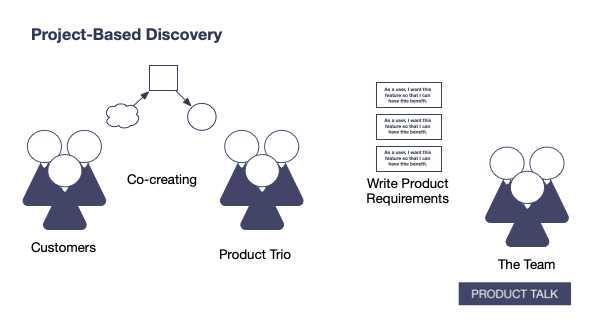Continuous Discovery
Teresa Torres is a thought leader in the product space who focused specifically on Product Discovery. In Continuous Discovery Habits she described her ideas toward a more modern approach to discovery.
We Measure Delivery — What about Discovery?
In the past decades, Product Delivery has improved massively. The industry moved from annual releases to quarterly releases to nightly builds to continuous integration. We measure code quality, bug rates, story points, team velocity, and many more. But for Product Discovery – not so much. So:
How do we know if we are doing a good job?
Teresa Torres | YouTube
In other words, how do we know whether we build the right things, the things that bring value to customers and business outcomes to the company? How do we know before spending huge budgets and failing very late?
Evolution of Product Discovery
This is where Continuous Discovery comes in handy:
In this presentation at ProductTalk 2020, Teresa gives a short overview of the history of discovery and then highlights the key aspects of continuous discovery:
We pull the entire team into Product Discovery, so there is no more Chinese Whisper and handover from stakeholder to stakeholder. We close the loop and, thus, discovery becomes a continuous process.

Key Ideas in a Nutshell
For details, see the full book (which we consider a must-read for any Product Manager). Here is only a quick summary of the key ideas:
- Form a product trio, a team involving PM, Design and Engineering to work on Discovery together. Include more experts when needed, but keep the team small.
- Select a business outcome to address, derive a product outcome that supports the business outcome, and define an outcome metric to measure success.
- Sketch the user journey for the product outcome in a user journey map or a similar tool.
- Conduct interviews, listen to customers, record the learnings e.g. in interview snapshots and, most importantly, gather pains, gains and desires as opportunities.
- Create an opportunity solution tree by organizing and structuring the opportunities collected.
- Prioritize on opportunity level, not features to build. Take the perspective of customers and select a single opportunity to work on. Keep it small so you can act fast.
- Ideate, discover solutions, dot vote for the most promising solutions, similar to deciding on the best ideas in discovery sprints.
- For the selected solutions, name and evaluate assumptions. Determine the most riskiest ones.
- Test assumptions with real users and customers, much like testing on day 5 in discovery sprints.
- Implement in production on a small scale and measure the real impact to assess whether the solution truly moves the needle of the product metrics towards the desired product outcome.
- Involve stakeholders, explain the journey, utilize the same artifacts as used during Product Discovery.
- Manage the whole process, backtrack when needed, and keep the wheel going.
Further Reading

Continuous Discovery Habits
Discover Products that Create Customer Value and Business Value

